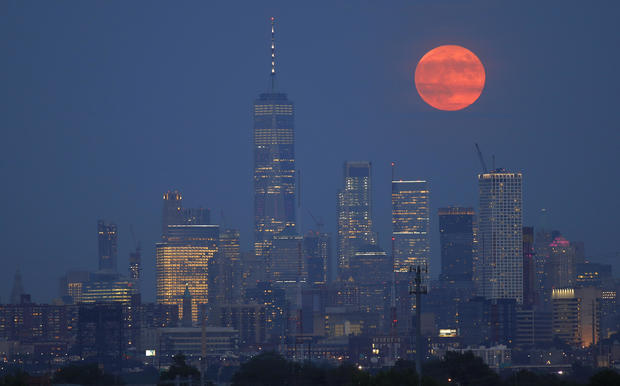#CIVILIZATION
Canadian researchers help find evidence of ancient ochre mine in Mexican caves
Caves hold some of the best-preserved evidence of earliest humans in western hemisphere
CBC/ The Associated Press · Posted: Jul 03, 2020

A diver from Centro Investigador del Sistema Acuífero de Q Roo (CINDAQ A.C.) examines the oldest ochre mine ever found in the Americas, used 10,000-12,000 years ago by the earliest inhabitants of the Western hemisphere to procure the ancient commodity. (CINDAQ.ORG)
The caves are vast, pitch-black, full of twists and turns and treacherously tight in spots.
New research reveals why ancient inhabitants of Mexico's Yucatan Peninsula may have ventured deep into the underground labyrinths despite the danger: to mine red ochre.
A paper published Friday in the journal Science Advances says there is evidence of people prospecting for the red pigment thousands of years ago in what is today the state of Quintana Roo.
It seems the resource was especially abundant in a part of the cave network known as La Mina Roja, said Eduard Reinhardt, one of the study's authors.
"This was a bonanza," said the McMaster University geo-archaeologist and expert cave diver.

A diver collects charcoal samples from the ochre mine. (CINDAQ.ORG)
"This activity of mining, finding the ochre, extracting the ochre would have been a pretty big endeavour."
For a hunter-gatherer society to put in so much effort, he said, "it must have been pretty valuable."
The researchers say humans were frequenting the cave networks between 10,000 and 12,000 years ago. They would have shared the landscape with now-extinct megafauna like sabre-toothed tigers and giant ground sloths.
Back then, the caves were dry and farther inland. Today, they are underwater and accessible via openings called cenotes.
Caves like a 'rabbit warren'
Ancient human remains have previously been found in Quintana Roo caves, including the 13,000-year-old skeleton of a teenage girl in the Hoyo Negro cavern in 2007. But until now, scientists didn't know the reasons behind the risky subterranean excursions.

A landmark of piled stone and broken speleothems left 10,000-12,000 years ago by the earliest inhabitants of the Western hemisphere to find their way in and out of the mine. (CINDAQ.ORG)
Members of CINDAQ, a local cave diving team, were exploring an area of deep tunnels in 2017 and found what they thought could be human disturbances. They reached out to Mexican cultural authorities and academic experts were brought in to investigate.
Reinhardt, who has been in the caves, compared them to "Swiss cheese" or a "rabbit warren."
"You have to be very, very careful about not getting lost," he said. "You've got passages that kind of loop around and interconnect and then branch off and then connect into other systems."

A diver examines an ochre mine pit and mining debris. (CINDAQ.ORG)
Many of the passages are a comfortable 25 metres wide but have ceilings less than two metres high.
Some areas are a tight squeeze at just 70 centimetres wide.
"You've really got to basically get on your back and kind of wiggle your way through."
Tools, fire pits found
The paper describes cairns and broken-off stalagmites and stalactites that could have been used as route-markers, as well as the remnants of fires likely used to illuminate passages up to 650 metres away from sunlight.
At mining sites, divers have found orderly rock piles and tools used to smash up the stone.
The hot, humid climate of the Yucatan has destroyed most above-ground evidence of those who lived there during an age known as the Pleistocene-Holocene transition.
WATCH | Canadian researchers help find evidence of earliest humans in western hemisphere

Watch
Canadian team helps find evidence of earliest humans in western hemisphere
16 hours ago 7:10
Researchers find 12,000-year-old tools, fire pits preserved in cave in Mexico 7:10
But artifacts have been remarkably well preserved in caverns that became submerged as sea levels rose 7,000 to 8,000 years ago.
"It's this kind of time capsule," said study co-author Brandi MacDonald, an archaeological scientist at the University of Missouri who studies ochre deposits around the world.
"We're able to see what it looked like more or less as it was when it was abandoned."
MacDonald, who completed her PhD at McMaster, said evidence of the mine's intensive use over a 2,000-year span suggests knowledge and skills were being passed generation to generation. It's also possible ochre-mining was a large-scale regional industry, as there is evidence of prospecting in multiple locations.

A diver explores the ochre mine, which holds some of the best-preserved evidence of ancient peoples in the western hemisphere. (CINDAQ.ORG)
Reinhardt and MacDonald said further exploration of the caves could reveal how extensive and long-lasting ochre-mining was. The research team which also included cave exploration expert Fred Devos, originally from Stratford, Ont.
MacDonald said ochre — a mix of iron oxide, clay and other minerals — is most often associated with ancient cave and rock paintings.
The researchers don't know how early Yucatan residents used the material, but elsewhere in the world there is evidence of it being used in mortuary practices and rituals.
It might have had utilitarian uses on top of religious ones. The ochre found at La Mina Roja, for instance, contained enough arsenic to perhaps be an effective insect repellent.
"It's the kind of material that humans have been using for literally hundreds of thousands of years," said MacDonald.
"Ochre is such a universal material in terms of human history."
ANCIENT HUMAN CIVILIZATIONS DID NOT JUST CREATE TOOLS BUT TECHNOLOGY FOR MASS PRODUCTION IN THE CASE OF OCHRE THIS ALSO OCCURS IN FINDS IN SOUTH AFRICA THAT DATE
BACK EARLIER THAN MEXICO RECENT FINDS HAVE REVEALED INDUSTRY MEANS CIVILIZATIONS, COMMUNITIES THAT ALLOWED FOR MORE NOMADIC HUNTER GATHERS TO COME AND TRADE FOR OCHRE
THOUGH YOU CAN BE SURE SOMEONE WILL COME UP WITH AN ATLANTEAN UFO CRYSTAL SKULL HYPOTHESIS LOOKING TO BECOME A THEORY















